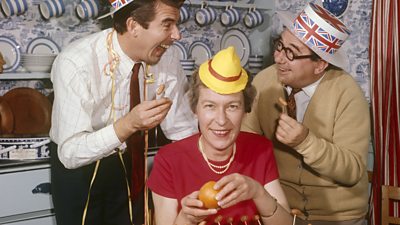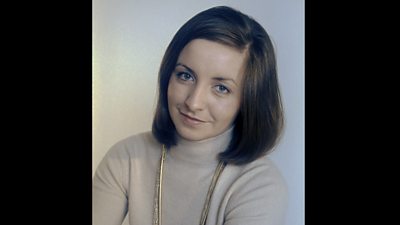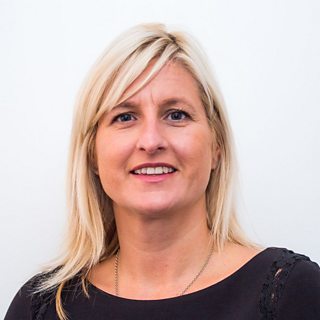It was Hilda Matheson who in 1928, as the first Head of Talks at the ���˿���, suggested that the microphone should not be addressed as though it were a public meeting, but that people at home should be addressed as though in person.
The arrival of television meant that presenting also involved the development of visual communicative skills whereby successful presenters were able to create intimate relationships with viewers at home.
The newly available ���˿��� Oral History Collection contains a number of interviews with female television presenters. Although by no means fully representative, these demonstrate a range of routes into presenting and illustrate the contribution women made to the distinctive styles of addressing the audience at home.

Judith Chalmers first presented for the ���˿��� at the age of 13 and learnt her skills on the radio programme Children's Hour, broadcast from Manchester. She was then approached by Trevor Hill, who produced children's programmes for the ���˿���, to work in television.
Her transfer from radio to television registered a need to think about visual style, as well the medium's immediacy and intimacy. Chalmers' audition for Children's Television Club was actually on a live programme in 1956 where, for the first time, she had to think about her appearance, as she later recalled on the ���˿��� programme Talkabout:
Another route to presenting was through cookery programmes. Marguerite Patten worked in the Food Advice division at the Ministry of Food during the war and had a presence on radio programmes such as Woman's Hour and Kitchen Front, and on post-war women’s daytime television programmes such as Designed for Women and For the Housewife.

Patten's recipes tended to focus on the skills needed for the working woman to manage everyday cooking, especially during rationing with excerpts like 'cheaper meats'. Marguerite Patten was important to television’s role in talking to and 'educating' the housewife at a key moment in post-war recovery.
In 1956, she became the presenter of a new programme, Cookery Club. An innovative feature of the programme was for housewives to send in their recipes, with the winner invited to come into the studio to make their dish live on television.
In 1959, Zena Skinner began presenting for Cookery Club. She had developed her cooking skills as a 'demonstrator' for the Electricity Board when she was famously photographed in East Africa by the press. The producer of Cookery Club saw the photograph, and invited her for an audition.

As she describes in her oral history interview, for the audition, she had to showcase her skills of demonstrating and presenting which included improvising a paper file as a joint of beef:
Skinner was more 'down to earth' than the other well-known contemporary cookery presenter Fanny Cradock. Cradock had demonstrated for the British Gas Council, but gained some popularity through her column for the Daily Telegraph.
Cradock's first ���˿��� show was Kitchen Magic in 1955 where she was famed for dressing up, even sometimes wearing a tiara. Skinner, by contrast, was loved because of her deliberate 'no-nonsense' authenticity.
When asked in her oral history interview if she wanted a helper on Cookery Club she refuses, "well what housewife has a helper?"
This is one of the ways through which Skinner developed an intimate and personal relationship with her viewers, as she says, "I wanted to be the housewife's friend".
Zena Skinner presented for the ���˿��� until 1989, working on Town and Around, Ask Zena Skinner and Bon Appétit.

Whilst many early presenters working on daytime television dealt with broader political issues than is often understood from the domestic focus of the programmes, increasingly it was women journalists who made their presence felt.
Sue Lawley was one of those who became a ���˿��� television presenter through this route. She was important to the development of popular news and consumer journalism on Nationwide (1969 - 1983), the popular early evening weekday magazine show on ���˿��� One which combined political analysis with consumer affairs from around the regions.
The programme upset some traditions in news at the ���˿��� because of its mixing of current affairs with softer news such as the famous 'skateboarding dog'. In her oral history interview, Lawley described its popularity through the way it spoke to the nation:
"Nationwide existed to talk to the ordinary man in the street in a way that he understood and enjoyed. And it would be- it was a great trick. The trick is to explain things very carefully, to spell them out, but never to patronise. Very, very difficult line to tread but if you tread it you have success on your hands, because people like you and trust you. And you the respect them in return and there becomes – Nationwide was the nation talking to itself really." - Interview with Sue Lawley, 2014. From the ���˿��� Oral History Collection.
Presenting ���˿��� Election Results programmes became part of Sue Lawley's repertoire, and from 1974 she was a regular on such programmes, embedding her status as a serious political journalist.
Sue Lawley is also famed for hosting the interview that upset Margaret Thatcher. This was when a member of the public was allowed to question Thatcher's decision-making in the sinking of the Belgrano during the Falklands War. It was broadcast on Nationwide on 24 May 1983:
The infamous evening was recalled in a special feature for Radio 4 Extra 30 years later.
Having spent some time on the Nine O'clock News, Lawley then became the main anchor for the new Six O'clock News in 1984. She brought with her the presenting skills she had developed for Nationwide where traditional journalism had been re-written:
'cos it had to fit in your mouth, that's the other thing you know, you weren't a puppet, and it had to have our style and we had to get rid of these tabloid phrases.
Nationwide and the Six O'clock News represented real challenges in style to the more macho journalistic culture of news at the ���˿��� which was influenced by print journalism.
The Six O'clock News helped to change the style of news broadcasting overall on the ���˿��� which would subsequently develop a more conversational and less didactic style of presenting. Whilst presenting the news, Sue Lawley also hosted the chat show Wogan in 1988, and the Radio 4 programme Desert Island Discs from 1987-2006.
Women presenters have therefore been central to the development of key televisual presenting skills and popular shifts in register as they have talked to people in their homes from the ���˿���.

